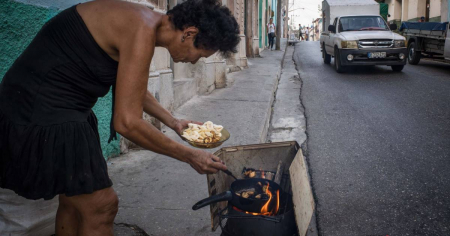In Cuba, lighting a charcoal stove is not a scene from the past nor a rural curiosity, it is the only alternative for many families in the face of the fuel crisis, especially the shortage of gas.
This is shown by @sheyreyes03, a user of TikTok who decided to document in a video how cooking is done today on the island. What started as a practical explanation quickly turned into a poignant portrait of the everyday reality of thousands of Cuban homes.
Sheyla starts by showing a zinc plate placed on the stove to prevent the rice from burning. In front of the camera, she begins to add charcoal to the burner, ready to ignite it with a mixture of kerosene and gasoline.
Oil is super expensive because it's 1L at 350 pesos and well, you all know gasoline is at 400 pesos. We add these 2 things to light it properly, there are people who do it with paper, with banana leaves because they have neither oil nor gasoline. So they have to get creative however they can to light the charcoal, because this is what most Cubans are using to cook, the young woman emphasized.
The post sparked a wave of reactions. Among sadness, concern, and empathy, users quickly began to share their own experiences and feelings.
Someone wrote: "No, and right now the coal is running out... because everything is like this in Cuba. How sad, Cuba hurts."
Others shared less expensive alternatives, such as using oil instead of fuels, warning that oil or gasoline “can alter the taste of food.”
Creativity is not lacking. A follower recommended using a simple candle, because "it lights faster if you don’t have gasoline, it helps them a lot".
Meanwhile, another voice was raised with an environmental reflection: "They are going to destroy the forests and trees to make charcoal; I think that is not right. Will those who make charcoal have any controls?".
“By the way, food cooked over charcoal has a delicious flavor,” noted a user, as if finding a small consolation in a challenging situation.
This video does not showcase a cooking technique; it illustrates the daily struggle for something as fundamental as feeding oneself. On an island where gas is scarce and prices are skyrocketing, cooking has become an act of survival, and lighting the charcoal is just the first step in a routine that requires ingenuity, sacrifice, and resilience.
The growing dependence on coal has led to an increase in its demand and, consequently, its price. In provinces like Holguín, a bag of coal reached a cost of up to 1,400 pesos in February 2025, becoming a luxury for many families who need it for cooking amid constant power outages.
The lack of electricity and liquefied gas supply has forced some people to improvise cooking stoves in their yards, using wood and charcoal, which poses a risk to health and safety.
The increase in the use of coal and firewood has also raised environmental concerns. The logging of trees for coal production can lead to deforestation and other ecological problems. Additionally, the burning of these materials contributes to air pollution, affecting the health of the population.
Frequently Asked Questions about the Situation of Charcoal Cooking in Cuba
Why are families in Cuba using coal for cooking?
Families in Cuba are using charcoal for cooking due to the scarcity of gas and electricity. The fuel crisis has left many with no alternatives, forcing them to turn to traditional methods such as using charcoal, despite its high costs and the associated environmental impact.
What are the alternatives to using traditional fuels to ignite charcoal in Cuba?
In the absence of oil and gasoline, which are expensive, Cubans are using paper, banana leaves, and even candles to light charcoal. These alternatives aim to mitigate the high fuel prices, although they can also alter the flavor of the food.
What impact does the use of coal have on the environment in Cuba?
The use of coal can lead to deforestation and air pollution. The cutting down of trees for coal production and the burning of this material have negative effects on the environment and public health, raising concerns about sustainability and air quality.
How is the energy crisis affecting daily life in Cuba?
The energy crisis in Cuba impacts families' ability to cook and store food, due to frequent blackouts and the lack of gas. This has forced people to turn to alternative methods and face high food costs, worsening their quality of life and causing widespread discomfort.
Filed under:
